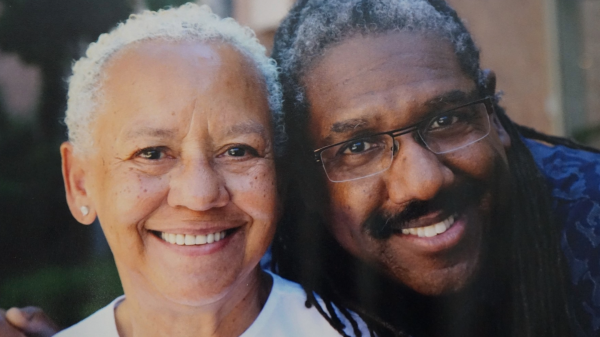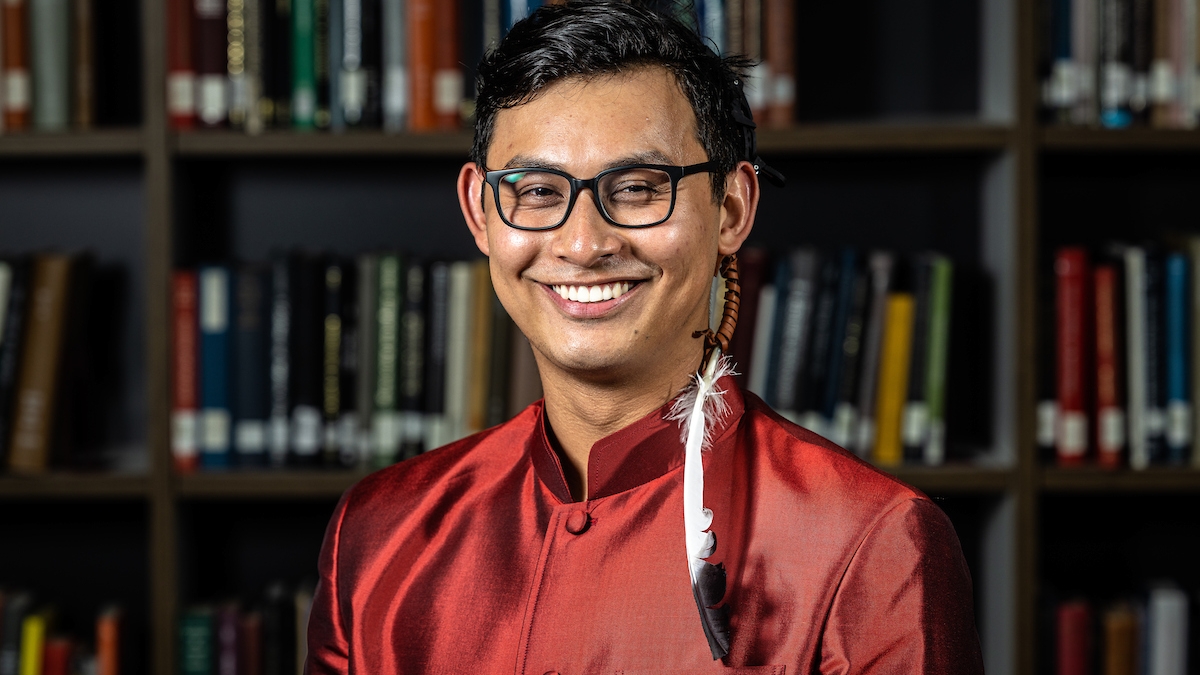Editor's note: The story is part of a series of profiles of notable spring 2023 graduates.
Arizona State University doctoral student Lennon Audrain won’t have to send out resumes after graduation or go hunting for a job. He’s already entrenched in his field.
“In February I defended my dissertation, and by March I started my new job,” said Audrain, who will be awarded his PhD in educational policy and evaluation from ASU in May and is now a research assistant professor at Mary Lou Fulton Teachers College. He leads the strategy on the Next Education Workforce Initiative's Teacher and School Leader Grant, an $8 million U.S. Department of Education grant awarded to ASU in partnership with Mesa Public Schools.
In addition to his role as a research professor, Audrain instructs a grow-your-own teacher program designed to generate and sustain high schoolers' interest in the education profession, at Skyline High School in Mesa Public Schools. Previously, Audrain taught Latin, Spanish and English in both Arizona and Massachusetts.
An enrolled member of the Cherokee Nation and Shawnee Tribe, Audrain is very accomplished for a 23-year-old. After finishing his associate degree in education at Rio Salado College five months before he graduated from high school, it took him only a year to obtain his bachelor’s degree in classics from ASU. He was the youngest graduate from both his master’s classes at ASU and Harvard University. He earned his first master’s degree in curriculum and instruction from ASU at age 19 and his second master’s degree in technology, innovation and education from the Harvard Graduate School of Education at age 21.
“In Greek there’s a word – kairos – it’s about timeliness,” Audrain said. “My motivation behind these degrees was wanting to learn how to explore problems through multiple lenses. Education has changed so rapidly over the past few years that we need timely solutions — from multiple lenses — to these pressing problems.”
ASU News caught up with Audrain a few weeks before he dons his cap and gown and collects his fifth higher-education degree in six years.
Question: What was your “aha” moment when you realized you wanted to study teaching?
Answer: I come from a family of teachers, so teaching as a career was “in the family.” My mom studied teaching and was a teacher in Thailand before immigrating to the United States, and my dad is a teacher now. In middle school, I toyed with the idea of becoming a teacher. The thought, “hey, I really want to do this” really actualized when I had my Latin teacher, Ms. Balcom, in high school at Brophy College Preparatory. I realized I wanted to do what she did — both content-wise and the way she made me feel. She brought passion, energy, excitement to a dead language, and I wanted to bring the same to students.
Q: What’s something you learned while at ASU?
A: I’ve learned a lot of content at ASU: a few dead languages (Latin and dabbled in Ancient Greek), lots about the science and art of teaching and learning, and a lot about educational policy. The biggest thing I’ve learned at ASU is how important it is to build a cadre of individuals around you — a team — who will be your thought partners while you try to solve problems and the team who will celebrate you when you make progress, together. I’ve learned that wicked problems are best solved with a team of experts — whether you’re trying to translate a line from Cicero’s "in Catilinam" or looking for ways to remedy staffing challenges in schools.
Q: Why did you choose ASU?
A: I chose ASU because of its belief that the institution has a “fundamental responsibility for the economic, social, cultural and overall health of the communities it serves.” As an emerging education policy scholar, there is no better feeling than watching your research go into practice, and watching practice inform research — and watching research and practice drive principled innovations. I have been lucky enough to witness principled innovation in action and join in the work with the Next Education Workforce initiative at ASU’s Mary Lou Fulton Teachers College to redesign schools and schooling for learners and educators.
American students deserve access to high-quality educational experiences and educators, and the Next Education Workforce initiative is pushing the transformation of education systems in ways that learners and education need — and deserve.
Q: What’s the best piece of advice you would give to students?
A: Find your folks! Friends, professors, staff — don’t be afraid to strike up a conversation, to make a new relationship. School is as much about learning content and skills as it is about learning how to work with others. Don’t be afraid to reach out.
Q: What was your favorite spot on campus?
A: When I was an undergraduate, Hayden had closed for renovations. Luckily, as I was writing my dissertation over the past few months, Hayden was open — and I spent a lot of time on the fourth floor. I would end every night perusing ASU’s collection of Loebs (a collection of Latin and Ancient Greek books), but typically, I landed in the words of Catullus. Although he was talking about his love interest in poem 85, he described the process of writing a dissertation best, writing odi et amo — I hate and I love! Aside from Hayden, I enjoyed the Memorial Union for a coffee break and Farmers atrium when it wasn’t humid.
Q: What are your plans after graduation?
A: I have been appointed a research assistant professor in ASU’s Mary Lou Fulton Teachers College. I am leading the strategy on the Next Education Workforce initiative's Teacher and School Leader grant, an $8 million U.S. Department of Education grant awarded to ASU in partnership with Mesa Public Schools to redesign human capital management systems in education.
In addition to my role as a research professor, I will also continue to teach CTE Education Professions, a grow-your-own program designed to generate and sustain high schoolers' interest in the teaching profession, at Skyline High School in Mesa Public Schools. In CTE Education Professions, we tutor students at a local elementary school up to four times a week.
I am excited that I get to have a foot working in education systems-level transformation while keeping a foot in the classroom. ASU is so committed to social-embeddedness that my role(s) empower me to work collaboratively to transform systems, and I will still get to interact and learn with and from K-12 students every day.
Q: If someone gave you $40 million to solve one problem on our planet, what would you tackle?
A: If I could tackle one problem with $40 million, I would try to solve the perennial school staffing shortages that we face around the world. Students around the world deserve access to — and the outcomes from — good teachers who can deliver meaningful learning experiences, and those teachers deserve high-quality working conditions. We have to build a better workforce, and I think a nice $40 million could start to move that work forward.
Top photo: Lennon Audrain will soon receive his doctoral degree from the Mary Lou Fulton Teachers College. His parents also met at ASU. He is photographed in a traditional Thai shirt and a feather in his tam to honor his Thai and Native heritage, on April 12 in Hayden Library. Photo by Charlie Leight/ASU News
More Arts, humanities and education

School of Social Transformation faculty member assumes new title with NSF
School of Social Transformation faculty member and Founding Executive Director of the Center for Gender Equity in Science and Technology (CGEST) Kimberly Scott is accepting a new position…

ASU's Neal Lester reflects on life, death of poet Nikki Giovanni
When Neal Lester heard on Monday that poet and activist Nikki Giovanni had died, the news hit hard.Lester, the founding director of Arizona State University’s Project Humanities and a Foundation…

Learning by stepping outside
By Adriana MaestasAmid a world increasingly captivated by all things digital, more than 200 Arizona teachers have crafted immersive educational experiences that nudge students to step away from their…
